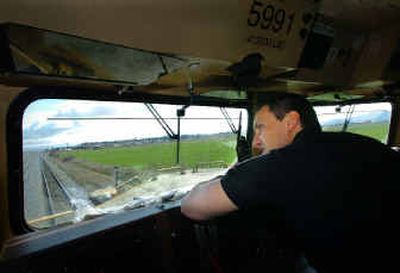Train patrol keeps drivers off track

Chris Arvas will never forget the last train-car collision he personally experienced.
An engineer for 32 years, he’d been at the controls of trains 15 times when they slammed into cars or trucks at railroad crossings, sometimes killing the occupants.
The most unforgettable collision, however, was the time a pickup tried to beat his train and Arvas applied the emergency brake. The pickup made it across the tracks, but the small sports car that followed it didn’t.
“The last thing I saw was a little girl looking up at me,” he recalled Thursday from the cab of a Union Pacific locomotive crossing the Rathdrum Prairie. “When I walked back there, I thought that we killed them. When I saw they were OK, I wanted to kill the mother, so I took a long walk.”
The trauma of his engineering days has brought Arvas back into locomotives to teach drivers to respect the destructive power of trains and abide by the rules of railroad crossings. As Idaho’s coordinator of Operation Lifesaver, Arvas travels the state to coordinate emphasis patrols and educate the public about traffic laws.
On Wednesday and Thursday, he was riding with Idaho State Police troopers in locomotives as they traveled through North Idaho, trying to catch scofflaw drivers.
They nabbed about 50 on Wednesday and several dozen more Thursday, according to the ISP.
As ISP Trooper Paul Burke peered out the front of the engine, armed with a radio, a half-dozen other troopers and Kootenai County sheriff’s deputies lurked near the crossings from Beck to Greensferry roads early Thursday. The Union Pacific loaned an engineer, a conductor, its tracks and two locomotives – hitched back to back – for the day.
Before they even started the emphasis patrol, the crew witnessed impatient drivers. As the lights started flashing at one crossing, a driver did a U-turn before even noticing that the train was just two locomotives long.
And once Burke was aboard, the first crossing they came to, Pleasantview Road, was the scene of the first violation – a pickup zipped across the tracks after the signal lights started flashing and engineer Scott Draggoo started blowing his whistle. A moment later, a trooper was pulling over the driver. Crossing after the lights start flashing is a misdemeanor, punishable by a fine of up to $100.
Troopers and deputies also stopped drivers for failing to stop at “passive” crossings, where just a stop sign or cross-bucks mark the tracks. Many drivers don’t want to wait for the train to approach and pass, but sometimes they misjudge the speed, Arvas said.
If a train is a mile long and traveling at 60 mph, it takes only a minute to pass. Traveling at 20 mph, it takes three minutes.
“If they’re really that late for work, they should get up earlier,” conductor Otto Ray said. “Especially if you live here, where there’s lots of trains. It doesn’t hurt to get to work a little early.”
Draggoo, the engineer, said he’s had a lot of close calls but hasn’t hit anyone in his six years on the job.
It’s a helpless feeling, Arvas said. “Imagine that you’re driving a car 60 mph and you hit a patch of black ice and a kid runs in front of you.”
Arvas noted that the average train weighs 12 million pounds and, going 50 mph, takes a mile to stop. As soon as a driver sees the flashing lights of a crossing guard or hears a train whistle, the law requires the driver to stop and wait for the train to pass, he said.
Many folks in North Idaho ignore those laws, however. The area has more train-car collisions than other parts of the state except the stretch of tracks between Boise and Nampa. Of the 24 collisions statewide last year, nine occurred in the three northernmost counties.
Washington had 57 railroad crossing collisions last year in which four people died, according to Chris Adams, of the Federal Railroad Administration. This year, one person has died in the state at a railroad crossing.
Arvas believes Operation Lifesaver has saved many lives since the Idaho State Police started the program in Coeur d’Alene in 1972. About 1,200 people were killed at railroad crossings nationwide that year, he said. After the first year of the program, the state had a 39 percent reduction in accidents.
In 1990, Arvas said, Idaho had 88 collisions at railroad crossings, and that declined to 18 in 2003.
Last year, the number of collisions rose to 24, which resulted in four deaths. This year, the state has had six collisions, including one in Kootenai County last month in which a train hit a dump truck in Hayden. No one was seriously injured in that accident.
While Operation Lifesaver attempts to educate the public to “look, listen, live,” the Idaho Department of Transportation is gradually upgrading the state’s 1,439 public crossings. Of those, only 329 have crossing lights, gates or both, said Joe Peagler, state rail and highway safety specialist.
The state has a budget to install about five signaled crossings a year, and Peagler is constantly upgrading the statewide priority list. Scheduled for improvements in the next couple of years in North Idaho are crossings at Hayden Avenue in Hayden, Riverside Street in Bonners Ferry, Chase Road in Post Falls, Mill Street in Rathdrum and Boekel Road north of Hayden.
But even high-tech crossings, with gates and flashing lights and bells, don’t always make a difference, Arvas said: “Fifty percent of car-train collisions occur at crossings with lights and gates.”